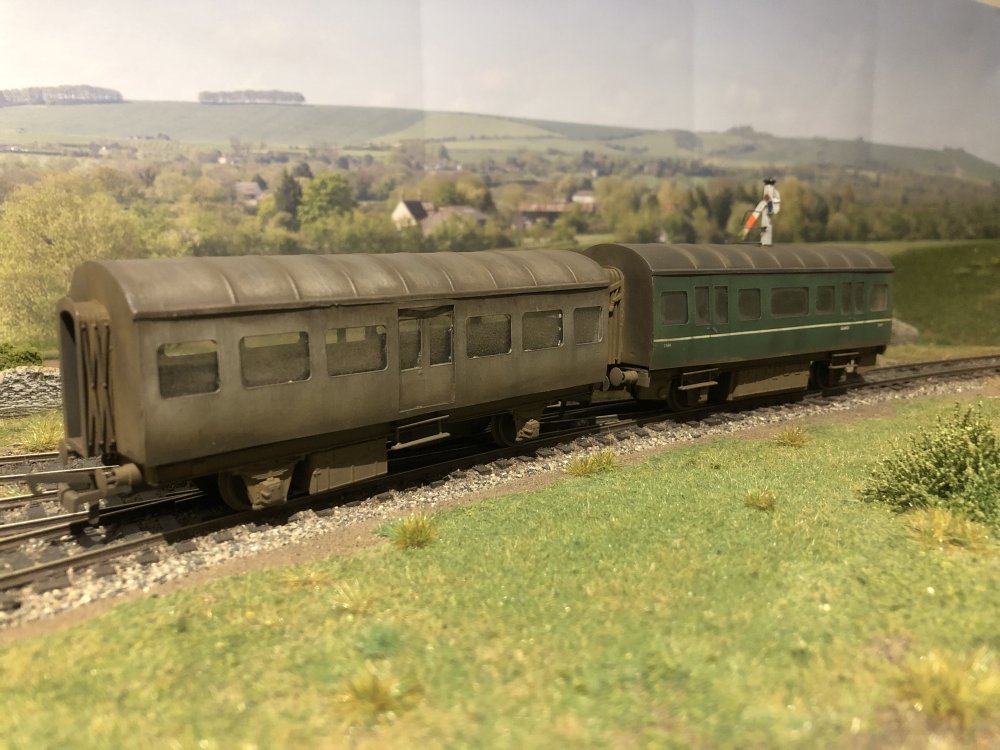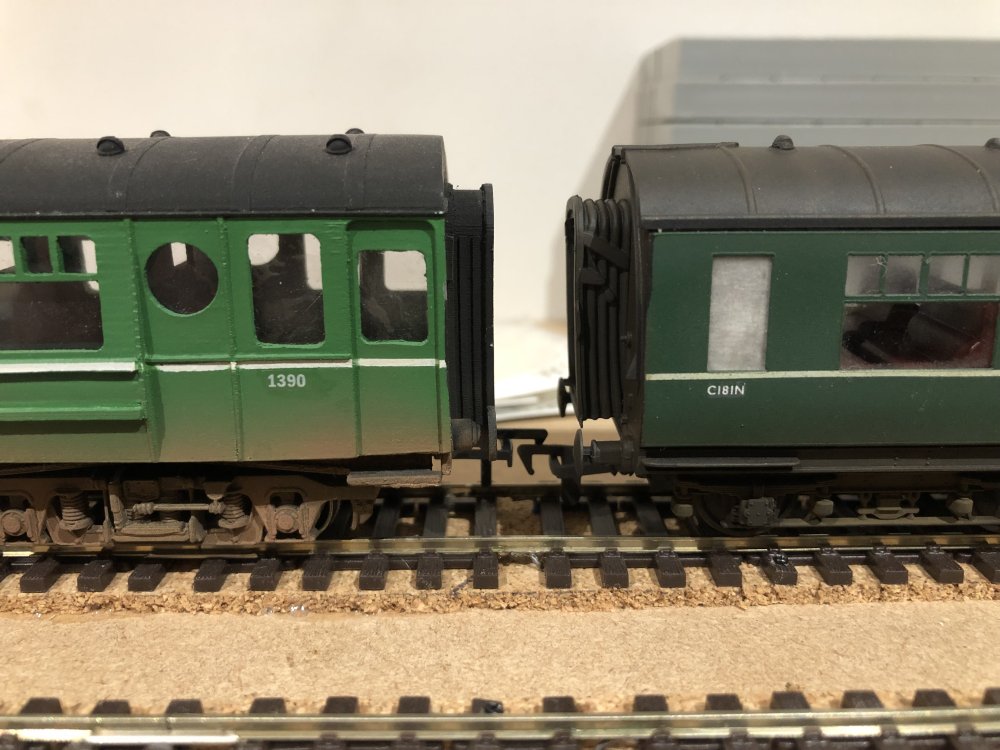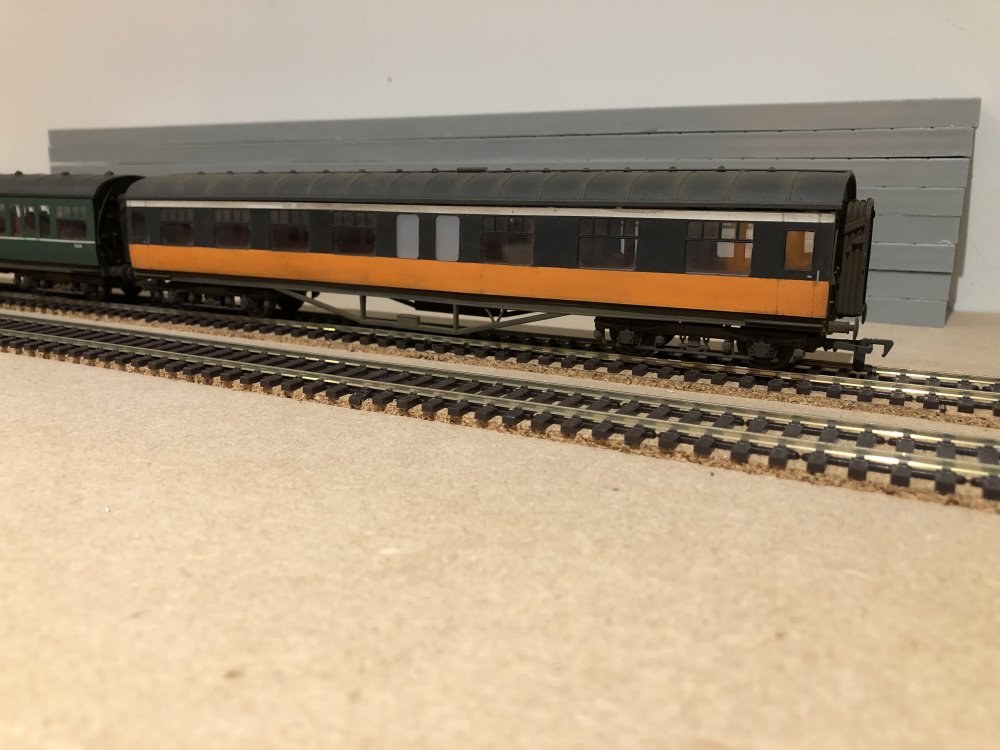-
Posts
15,831 -
Joined
-
Last visited
-
Days Won
393
Content Type
Profiles
Forums
Events
Gallery
Blogs
Store
Community Map
Everything posted by jhb171achill
-
6-wheeler with centre pair removed. There was one ex-MGW one which was treated like that too. The plain unlined maroon livery was common from very early 30s on little-used spare stock, to which these things had been relegated at the time.
-
Yes, I do know.
-
Schull and Skibbereen locomotive green shade
jhb171achill replied to Colin R's topic in General Chat
This is one which has no definitive surviving information, as I understand. However, I have a note somewhere which has it as a “dark grass green”. As well as J I C Boyd, Cyril Fry and the late Montgomery of Bray were highly knowledgeable livery experts. James Boyd specialised, as one might expect, with narrow gauge, though he was highly observant also on matters NCC, BCDR, GNR & GSR. It’s so long since I spoke to Boyd & Montgomery (fifty years or so) that I can’t recall who told me the details I have on Cork narrow gauge, and both they and Fry, jhbSenior and jhbSeniorsenior are all pushing the weeds up now….. I’ll take a few pics of Fry’s narrow gauge liveries next time I’m in the museum (which will possibly be this afternoon!). -
Interesting! My sharpest curve is, I think, just over 2ft radius........
-
I await with great interest!
-
Now, comments. The first box I opened was the un-numbered 1951 CIE coach, seen in the last picture. It actually looks better in real life than the pic on SF's website. Very impressed, and runs nicely. The GNR one is structurally perfectly satisfactory, and again to me looks better in the flesh. Having specifically instructed Silverfox to paint the roof black - they have a habit of producing CIE stuff with light grey roofs - that was done. But the green....... The GNR was taken over at the end of 1958. Repaints into CIE or UTA livery started in 1959. CIE stopped painting things dark green in 1954/5. Not one solitary GN vehicle was ever turned out in dark green, yet here it is; and while the waistline is in the correct pale green (not clear in artificial light above), the "snail" is WHITE. I know I bang on about this, but why, oh why, oh why, cannot a manufacturer get such tiny details as a correct colour - correct! This coach now looks to be a UTA repaint, not a CIE one; in fact, I may well obscure the "snail", put UTA roundels on it, and concoct some tale that it's turned up at Dugort Harbour on a pigeon special from Lisburn. Complete repaint another option. Silverfox folks - if you're reading this, see the Park Royal adjacent to the ex-GNR K15; it's in the correct green. Not one thing the GNR ever possessed ever got this dark shade - plus, can we put pale green snails on things - please? No coach EVER had a white flying snail. Nor did ex-GNR carriages have the prefix "C" to the numbers; it would have been 181N - the "C" was only on railcars. This is really frustrating. I do not want to criticise a manufacturer of Irish models, especially (a) we need you all, (b) the SF range covers quite a few prototypes that there is no other commercial model of, and in many cases may never be in my lifetime, (c) as a fan of the BR "Blue" era too, i see that SF do a very impressive range of British Rail railcars which I'm unaware of anyone esle doing. But time and time again, Silverfox Irish liveries are tragically, and completely needlessly, wrong. I might add that on two occasions I have supplied details of corrections on various matters of that nature directly to SF, but had no answer. So I don't know what the problem is with getting such things right. There's no excuse for it. Despite all of that, I remain a very satisfied customer; while €87 is plenty to pay for a coach in the wrong livery, at least it can be repainted. Awkward, though, with the glazing on a K15, but necessary. The tin vans; again, very happy with them, though one pair of wheels on the "dirty silver" one keeps falling out - a little attention will secure it, though. But the green one - just no. None of them ever carried that livery. Silver, then LIGHT green, then black'n'tan. Will I be back for more SF stuff? Quite possibly - but I will stick to black'n'tan ones; I'm tempted by another of the above CIE 1951 coach. Until they get their CIE green livery right, it can't be recommended.
-
A man in a red suit came down my chimney (I don’t actually have a chimney) at some stage during the night of 24th / 25th. He left these behind him. It said “Silverfox” on the boxes they were in, though I know it was Santa. I’ll post the pics first, then comment. Top class weathering by my expert friend in Newry, known to all here.
- 62 replies
-
- 14
-

-
I’d love to see a working model of Ramsey!
-
Very true!
-
Supertrain livery - painted same standard orange as body (though obviously got dirtier and quicker!).
-
Was in it once many years ago - very impressive. Wish I’d had time to explore a bit longer….
-
Absolute masterpiece as always - can't wait to see the weathering!
-
An absolutely astounding achievement - very well done indeed.
-
Cue a pigeon, deltic and rat stew on the menu........
-
Superb work so far - a pity for such a drawback. New year, new paint!! If I had attempted this, my walls would have lots of dents…….
-
The Official Irish 'Might Have Beens' Thread
jhb171achill replied to minister_for_hardship's topic in General Chat
And people who could work all three gears on a SLNCR bus, and steer bald tyres as well, were even more valuable...........! -
The Official Irish 'Might Have Beens' Thread
jhb171achill replied to minister_for_hardship's topic in General Chat
This is about as perfect a set-up as possible for a small layout of the various different versions of your excellent takents, david. It combines realism with maximum use in minimum space, operational challenges in shunting to maximise interest, and all this without making it look too cluttered. A track layout like that, or with little variation, would suit any of your projects, plus those being discussed. -
The Official Irish 'Might Have Beens' Thread
jhb171achill replied to minister_for_hardship's topic in General Chat
I'm surprised he retained ANY career with them at all! -
The Official Irish 'Might Have Beens' Thread
jhb171achill replied to minister_for_hardship's topic in General Chat
The Lough Swilly timetables showed that for years…… obviously the CDR only did buses when the railway was closing, but a nice “imaginary” CDR line might have been Killybegs - Kilcar…. On a similar vein, a little to the south the SLNCR had a respectable network of bus routes on which their ancient scrapyard buses (16th century vintage) skipped across potholes…. -
The Official Irish 'Might Have Beens' Thread
jhb171achill replied to minister_for_hardship's topic in General Chat
Yes, very much so - and indeed - the British military authorities made that very case when the scheme was being discussed! On the other hand, their seafaring arm preferred Bantry owing to issues about servicing warships…. -
The Official Irish 'Might Have Beens' Thread
jhb171achill replied to minister_for_hardship's topic in General Chat
It was. I'm researching the Kenmare line at the moment. There was a proposal to extent it some 30 miles to Castletownbere. Along that entire route there is, and was, zero industry, almost no population; and it would have ended at a tiny, isolated sleepy little fishing village, having struggled its way through probably the most difficult terrain any railway would have encountered anywhere in Ireland. They were STILL smoking that pot well into the 1900s....! The reason was an imaginary huge transatlantic port, which was considered utter pie in the sky by anyone and everyone with even one hour's basic tuition in economics*, mail transport, geology, or climate knowledge of local seas....... (* We're talking here about those capable of counting to ten......) From north Donegal to south Cork, I can think offhand of twelve such schemes, some seriously promoted as late as 1920-ish, which would have vyed with each other for the greatest waste of money (public or private) in world history. In all reality, very much the antecedent of the crass self-publicity-serving undersea tunnel ideas of a deeply odious 21st century orange coloured man with a piece of yellow carpet on his head in Brexitstan......................! -
The Official Irish 'Might Have Beens' Thread
jhb171achill replied to minister_for_hardship's topic in General Chat
Yes, the amount of “crackpot” schemes at least equally the mileage of those built! Places of 150-200 people miles and miles from anywhere with three separate schemes each… The big narrow gauge one you’re thinking of - and probably the most inane proposal ever, anywhere - was the 3ft gauge Ulster & Connaught from Clifden to Greenore. It wouldn’t have involved the Donegal lines but it WOULD have involved new lines from Clifden and Galway meeting up about Shrule, then by studiously avoiding any population of more than a couple of hundred people, and crossing hundreds of acres of empty turf bogs, ended up at the Dromod end of the Cavan & Leitrim. Then onwards to almost the other end of that line, up to the Clogher Valley, along that and eastwards through an area with big engineering difficulties, down into Newry. At that point, the Greenore line would have become dual gauge. I dunno what they were smoking….. -
Indeed - all it needs is a tablecloth over it and a teapot............. (and choccy bikkies) And this is.........a MODEL??????????????????????? WOW!!! You've surpassed yourself (and most of the rest of us!)
-
It would be BCDR, rather than BNCR, to Ballynahinch Junction. The BNCR stock was of a very distinctive design, with flat sides. Unlike anything else in Ireland, and (like, it must be said, six-wheel stock of most companies) no more like the Hattons design than a Pendolino. In any event, by the time the NCC took over the BNCR, they had much fewer six wheelers left, as they were early advocates of bogies. What few they had probably ended their life on the Larne or Derry Central, of mouldering in sidings awaiting the next orangeman’s or Sunday school outing. The Hattons stock is close enough to several GSWR designs, but not really other Irish companies. Design wise they’re different too, from DSER of BCDR designs - but would suit them better than, say, GNR, MGWR or BNCR /NCC.
-
Indeed it was, though I’m not 100% sure of the shade. Probably not unlike a darker version of LMS maroon.
.png.c363cdf5c3fb7955cd92a55eb6dbbae0.png)








